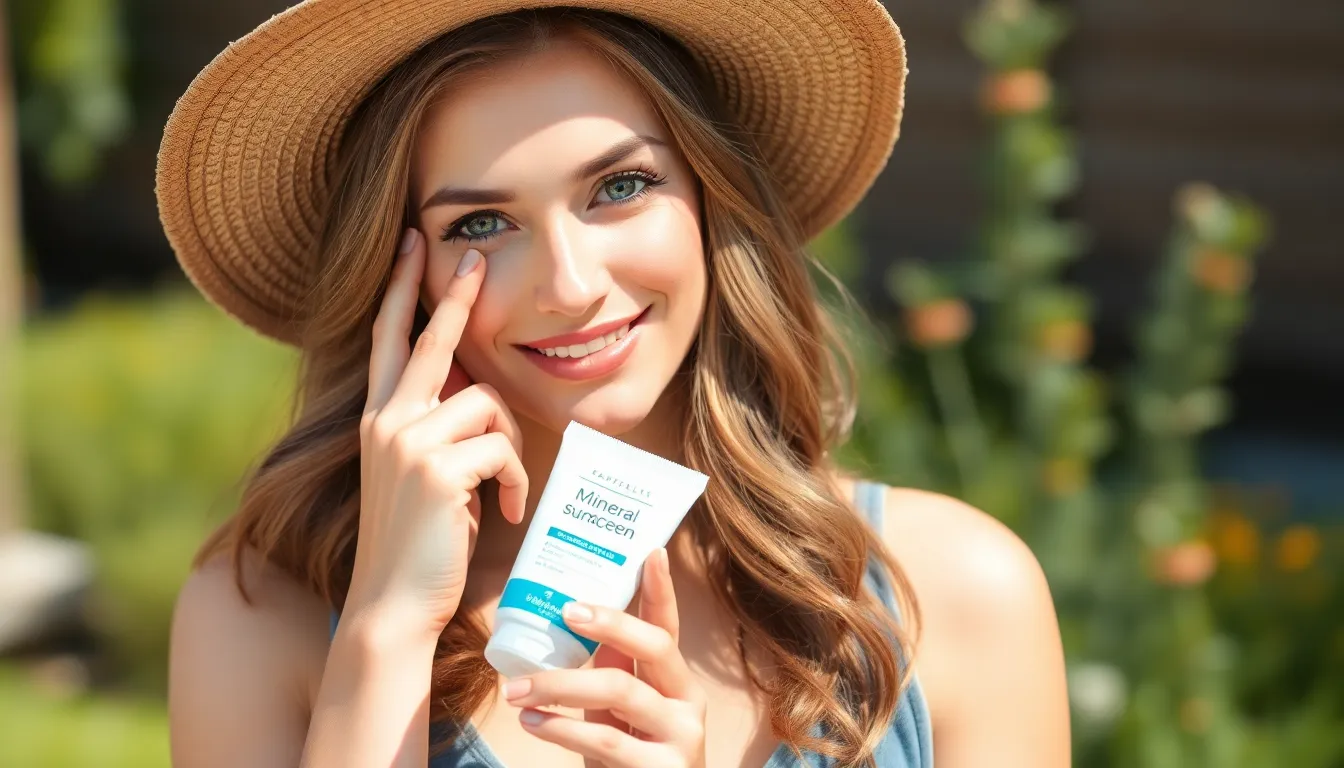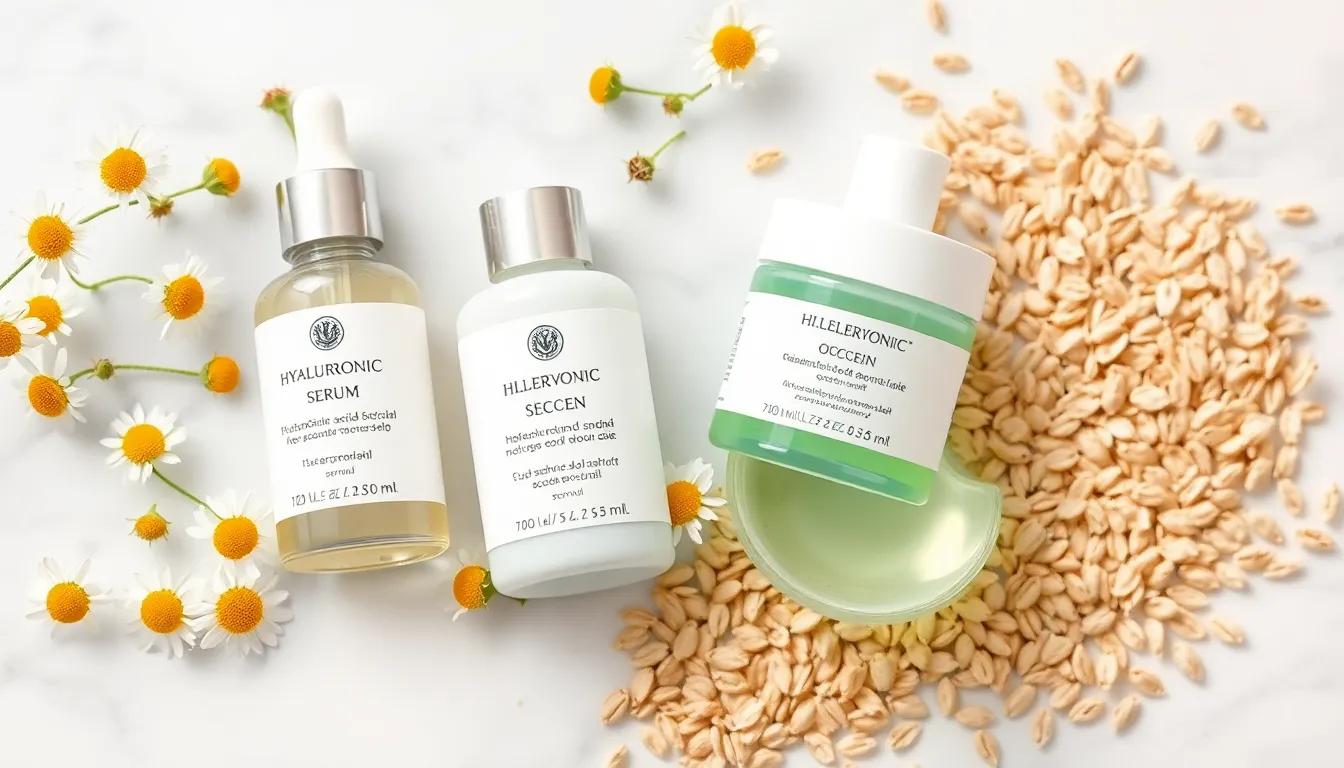Dealing with dry, sensitive skin can feel like walking through a minefield – one wrong product choice and you’re left with irritation, redness, or uncomfortable tightness. We’ve all been there, staring at endless skincare aisles wondering which gentle formulas will actually deliver the hydration our skin craves without triggering unwanted reactions.
The truth is, caring for dry sensitive skin isn’t about using more products – it’s about using the right products in the correct order. Your skin barrier needs special attention, and we’re here to guide you through creating a routine that soothes, protects, and nourishes without overwhelming your delicate complexion.
In this comprehensive guide, we’ll walk you through each essential step of building an effective skincare routine specifically designed for dry, sensitive skin types. From gentle cleansing techniques to powerful yet calming moisturizers, you’ll discover exactly how to transform your skin from stressed and dehydrated to comfortable, healthy, and glowing.
Understanding Dry Sensitive Skin: Signs and Symptoms
Before we jump into creating an effective routine, we need to understand what makes dry sensitive skin unique. Recognizing these signs helps us choose products that work with our skin rather than against it.
Identifying Dryness Indicators
Dry skin shows itself through several telltale signs that we can easily recognize. Tightness becomes most noticeable after cleansing or exposure to cold weather. Flaking appears on the surface as small white or gray particles that shed from areas like the cheeks, forehead, and around the nose. Rough patches develop in areas where oil production is naturally lower, such as the outer arms and legs.
Fine lines become more prominent when our skin lacks adequate moisture, particularly around the eyes and mouth. Dull appearance replaces our natural glow as dead skin cells accumulate on the surface. Uncomfortable sensations include itching that worsens at night and stinging when applying certain products.
| Dryness Indicator | Common Locations | When It’s Most Noticeable |
|---|---|---|
| Tightness | Face, hands | After cleansing, cold weather |
| Flaking | Cheeks, forehead, nose | Morning routines |
| Rough patches | Arms, legs, elbows | Throughout the day |
| Fine lines | Eyes, mouth | Under bright lighting |
Recognizing Sensitivity Triggers
Sensitive skin reacts to exact triggers that we should learn to identify and avoid. Environmental factors like wind, extreme temperatures, and low humidity levels can cause immediate reactions. Product ingredients including fragrances, alcohol, sulfates, and certain acids often trigger redness and irritation.
Physical irritants such as rough fabrics, harsh scrubbing, and overwashing strip our protective barrier. Stress affects our skin’s ability to repair itself and increases sensitivity to external factors. Hormonal changes during menstruation, pregnancy, or menopause can temporarily increase skin reactivity.
Allergic reactions manifest as burning, stinging, or swelling within minutes of contact with problematic substances. Immediate flushing occurs when our skin encounters temperature changes or exact ingredients. Persistent reactions continue for hours or days after exposure to triggers.
Common Skin Conditions Associated With Dry Sensitive Skin
Several skin conditions frequently accompany dry sensitive skin and require special attention in our routines. Eczema presents as red, inflamed patches that become intensely itchy and may weep or crust over. Dermatitis develops from contact with irritants or allergens, creating localized areas of inflammation and discomfort.
Rosacea affects the central face with persistent redness, visible blood vessels, and occasional bumps that resemble acne. Seborrheic dermatitis causes scaly, flaky patches primarily on the scalp, eyebrows, and around the nose. Keratosis pilaris creates small, rough bumps on the arms, thighs, and sometimes the face.
Contact dermatitis results from direct exposure to exact substances, causing localized reactions that can spread if left untreated. Photodermatitis develops from sun exposure combined with certain medications or products, creating exaggerated sensitivity to UV rays. Perioral dermatitis affects the area around the mouth with small, red bumps and scaling that worsen with topical steroids.
Choosing the Right Cleanser for Your Skincare Routine

Finding the perfect cleanser becomes the foundation of our dry sensitive skin routine. We need products that remove impurities without compromising our skin’s natural protective barrier.
Gentle Cream-Based Cleansers
Cream-based cleansers work exceptionally well for our dry sensitive skin needs. These formulations contain hydrating ingredients that cleanse without stripping away essential natural oils. We recommend choosing fragrance-free options to minimize potential irritation triggers.
Benefits of cream cleansers include their ability to leave skin feeling soft and nourished rather than tight or uncomfortable. They typically provide a cushioning effect during cleansing, protecting delicate skin from friction damage. Most cream-based formulas include emollients that help restore moisture while removing makeup and daily buildup.
Oil Cleansing Methods
Oil cleansers offer unique advantages for managing dry sensitive skin conditions. These products dissolve makeup and impurities by working with our skin’s natural lipid structure instead of fighting against it. We find that oil cleansing maintains moisture balance while thoroughly removing stubborn products like waterproof mascara.
Double cleansing with oil followed by a gentle cream cleanser provides comprehensive cleaning without over-drying. Oil cleansers help preserve the skin’s natural barrier function, reducing the dryness that harsh cleansing methods typically cause. Many people with sensitive skin report less irritation when incorporating oil cleansing into their routines.
Ingredients to Avoid in Cleansers
Certain ingredients can worsen our dry sensitive skin symptoms and should be avoided completely. Alcohol-based cleansers strip away protective oils and cause further dehydration. Sulfates like sodium lauryl sulfate create harsh detergent action that disrupts our delicate skin barrier.
Fragrances represent another major irritant category we must eliminate from our cleansing routine. Even “natural” fragrances can trigger sensitivity reactions in compromised skin. We should also avoid products containing harsh detergents, which can exacerbate existing dryness and cause stinging sensations.
Instead, we recommend seeking formulations specifically labeled as fragrance-free and designed for sensitive skin types. These gentler alternatives support our skin’s healing process rather than creating additional stress.
Incorporating Essential Moisturizing Steps

Building upon proper cleansing, we need to focus on the moisturizing steps that’ll transform your dry sensitive skin. These essential steps work together to restore hydration and strengthen your skin barrier for lasting comfort.
Lightweight Serums for Hydration
Lightweight serums containing pure hyaluronic acid become your skin’s best friend for deep hydration without heaviness. We recommend applying these hydrating serums after cleansing to deliver moisture directly into your skin cells. Hyaluronic acid serums plump the skin effectively while avoiding pore clogging issues that heavier products might cause.
Serums also target additional concerns like dullness or fine lines while prioritizing hydration as their main function. Choose formulations designed specifically for sensitive skin to ensure you’re getting maximum hydration benefits. Apply serums to slightly damp skin for enhanced absorption and better results.
Heavy-Duty Moisturizers for Barrier Repair
Heavy duty moisturizers become essential for nighttime barrier repair when your skin does its most important healing work. We suggest using richer creams formulated with ceramides and occlusives like petrolatum to restore lipids lost through dryness and sensitivity. These ingredients help strengthen your skin barrier and minimize cracks that could lead to irritation or infection.
Barrier repair moisturizers work differently from regular creams by focusing on rebuilding your skin’s protective layer. Look for non comedogenic formulations that won’t clog pores while delivering intensive moisture. Apply these heavier creams as your final step in your evening routine for maximum effectiveness.
Overnight Treatments and Sleeping Masks
Overnight treatments and sleeping masks provide the most intensive hydration boost while you sleep. We recommend incorporating these occlusive and nutrient rich products to enhance your skin’s natural repair processes without causing irritation. Sleeping masks work by creating a protective layer that prevents moisture loss throughout the night.
These treatments significantly boost moisture retention and support barrier recovery during your skin’s peak healing hours. Use overnight masks 2-3 times per week as needed for added moisture and repair support. Choose formulations with gentle ingredients that won’t trigger sensitivity while delivering maximum hydration benefits.
Selecting Sunscreen That Won’t Irritate Sensitive Skin

Protecting dry sensitive skin from UV damage requires careful sunscreen selection that won’t trigger irritation or worsen existing skin conditions. We need to focus on formulations that provide effective protection while maintaining our skin’s delicate balance.
Mineral vs Chemical Sunscreen Options
Mineral sunscreens stand out as the superior choice for dry sensitive skin because they contain zinc oxide or titanium dioxide that physically block UV rays. These ingredients sit on top of our skin and reflect harmful radiation rather than absorbing it into the skin layers.
Physical blockers like zinc oxide offer broad spectrum protection while remaining gentle and non comedogenic for sensitive skin types. We find these mineral formulations particularly soothing because they create a protective barrier without penetrating deeply or causing chemical reactions.
Chemical sunscreens contain organic compounds like oxybenzone that absorb UV radiation through the skin. Unfortunately, these formulations can cause irritation or allergic reactions in people with dry sensitive skin because they require absorption into skin layers to function effectively.
Active ingredients in chemical sunscreens often trigger sensitivity responses that manifest as redness, stinging, or burning sensations. We recommend avoiding these formulations if you experience frequent skin reactions or have diagnosed sensitivity conditions.
SPF Requirements for Daily Protection
Dermatologists consistently recommend using broad spectrum sunscreen with at least SPF 30 every single day to protect dry sensitive skin from harmful UVA and UVB rays. This protection level prevents moisture loss while shielding our skin from damage that accelerates aging and worsens sensitivity.
Daily application remains crucial even on cloudy days or when spending time indoors near windows because UV rays penetrate through glass and cloud cover. We need consistent protection to maintain our skin barrier integrity and prevent the dehydration that makes sensitive skin worse.
Broad spectrum formulations protect against both UVA rays that cause aging and UVB rays that cause burning. This comprehensive coverage helps our dry sensitive skin maintain its moisture balance while avoiding the inflammatory responses that worsen sensitivity symptoms.
Reapplication Techniques for Sensitive Skin
Apply sunscreen generously as the final step in your morning skincare routine after moisturizing to create the most effective protective barrier. We should wait a few minutes after moisturizer application to ensure proper layering without product interference.
Reapply every two hours when spending time outdoors or immediately after sweating or swimming using mineral sunsticks or sprays specifically formulated for sensitive skin. These specialized reapplication products minimize the rubbing and friction that can irritate already compromised skin.
Gentle patting motions work best for sunscreen reapplication because harsh rubbing can disrupt our skin barrier and trigger sensitivity responses. We recommend using clean fingertips or a soft makeup sponge to press product into skin rather than spreading it aggressively across the surface.
Avoiding Common Skincare Mistakes That Worsen Sensitivity

Even with the best intentions, certain skincare practices can backfire and increase sensitivity in already delicate skin. Understanding these common pitfalls helps us maintain healthier skin barriers.
Over-Exfoliation Dangers
Excessive exfoliation strips away our skin’s protective moisture barrier, creating a cycle of increased dryness and irritation. We often think more scrubbing equals better results, but dry sensitive skin requires minimal exfoliation to prevent damage.
Physical scrubs with rough particles can create microscopic tears in delicate skin tissue. Chemical exfoliants like AHAs and BHAs should be used sparingly, as they can overwhelm compromised skin barriers. We recommend limiting exfoliation to once or twice weekly maximum.
Enzymatic exfoliants offer gentler alternatives for those who need occasional surface renewal. These products work by dissolving dead skin cells without mechanical friction. Over-exfoliated skin shows signs like persistent redness, burning sensations, and increased flaking.
Harsh Ingredient Combinations
Layering multiple active ingredients creates a perfect storm for sensitivity reactions. Combining retinoids with strong acids like glycolic acid can cause severe irritation and compromise our skin’s natural defenses.
Alcohol-based toners paired with other drying ingredients amplify moisture loss exponentially. We’ve seen cases where mixing vitamin C serums with certain acids creates unstable formulations that irritate rather than benefit skin. Benzoyl peroxide combined with retinoids often triggers excessive dryness and peeling.
The key lies in introducing one active ingredient at a time, allowing our skin to adjust before adding others. Patch testing new combinations on small skin areas prevents widespread reactions. We should space out active ingredients throughout the week rather than using them simultaneously.
Frequency of Product Application
Using products too frequently overwhelms sensitive skin’s ability to recover between treatments. Many people apply serums and treatments twice daily when once daily or every other day would be more appropriate.
Our skin needs time to process and respond to active ingredients effectively. Applying recommended amounts matters as much as frequency – using excessive quantities doesn’t accelerate results but increases irritation risk. We often see people using multiple serums when one well-chosen product would serve them better.
Starting with every third day application helps gauge our skin’s tolerance levels. Night treatments should be used sparingly, typically 2-3 times per week maximum for sensitive skin types. Morning routines should focus on hydration and protection rather than multiple active treatments.
Building Your Morning Skincare Routine Step-by-Step

Morning routines require special attention for dry sensitive skin since we’re preparing our skin barrier for daily environmental stressors. We’ll walk through each essential step to create a protective foundation that maintains hydration throughout the day.
Gentle Cleansing Techniques
We recommend starting with a gentle, hydrating cleanser that removes overnight buildup without stripping your skin’s natural moisture. Look for formulations containing hyaluronic acid, which provides soothing and hydrating benefits while cleansing away dirt and oils.
Foaming cleansers pose important risks for dry sensitive skin types since they often contain harsh surfactants. We advise avoiding these aggressive formulations that can worsen existing dryness and trigger sensitivity reactions.
Apply your chosen cleanser using lukewarm water and gentle circular motions with your fingertips. Pat your skin dry with a soft towel rather than rubbing, which can cause irritation and micro-tears in delicate skin.
Layering Products in Correct Order
Toner Application: We suggest using an alcohol-free toner immediately after cleansing to restore your skin’s natural pH balance. These gentle formulations prepare your skin for better product absorption without causing dryness or irritation.
Serum Integration: Apply a hydrating serum next, focusing on ingredients like hyaluronic acid or vitamin C that brighten while strengthening your skin barrier. These concentrated treatments penetrate deeper when applied to slightly damp skin from your toner.
Moisturizer Selection: Choose a rich, nourishing moisturizer that’s specifically formulated as noncomedogenic for sensitive skin types. We recommend thicker cream formulations for dry skin, as they provide superior hydration and create a protective barrier against environmental stressors.
Final Protection Steps
Sunscreen application completes your morning routine and serves as your most crucial protective step. We emphasize using broad-spectrum SPF formulated specifically for sensitive skin with built-in moisturizing properties.
Choose mineral sunscreens containing zinc oxide or titanium dioxide, which physically block UV rays without penetrating your skin barrier. These formulations reduce the risk of irritation compared to chemical sunscreens that absorb into the skin.
Apply sunscreen generously to all exposed areas, including your neck and the delicate skin around your eyes. Reapplication every two hours becomes essential when spending extended time outdoors, even on cloudy days when UV damage still occurs.
Creating Your Evening Skincare Routine for Maximum Repair

Evening routines provide the perfect opportunity for intensive skin repair while you sleep. Your skin barrier works harder during nighttime hours to recover from daily environmental damage.
Double Cleansing Benefits
Double cleansing transforms your evening routine by thoroughly removing makeup, sunscreen, and accumulated impurities without harsh scrubbing. We recommend starting with a gentle cleansing balm that dissolves surface debris and stubborn makeup. Oil based cleansers break down waterproof formulas more effectively than single step cleansing methods.
Following your first cleanse, apply a hydrating cream cleanser like Phyto-Active Enzyme Cream Cleanser to complete the process. These gentle formulations maintain moisture levels while removing remaining traces of dirt and pollution. Cream cleansers prevent the tight, stripped feeling that foaming products often create on sensitive skin.
Benefits of this two step approach include deeper pore cleansing and reduced irritation compared to aggressive single cleansers. Your skin stays balanced and prepared for treatment products that follow. Evening double cleansing also removes daily buildup more effectively than morning routines alone.
Nighttime Treatment Applications
Hydrating serums work best immediately after cleansing when your skin can absorb active ingredients most efficiently. We suggest applying treatments that contain ceramides and antioxidants to support barrier repair overnight. These ingredients calm sensitivity while providing deep hydration without adding excess oil.
Target exact concerns with gentle formulations designed for sensitive skin types. Products containing hyaluronic acid deliver intense moisture to dry areas without causing breakouts. Antioxidant serums protect against environmental damage while you sleep.
Avoid harsh exfoliants or strong actives that can further irritate already compromised skin barriers. Evening treatments should focus on repair rather than aggressive renewal. Layer lightweight serums under heavier moisturizers for maximum absorption and effectiveness.
Skin Barrier Recovery Methods
Rich moisturizers like Vita E Essential Cream or Restorative Cream provide intensive overnight hydration for dry sensitive skin. We recommend these thicker formulations specifically for evening use when your skin can handle heavier textures. Night creams work to replenish lost moisture and strengthen protective barriers.
Apply your evening moisturizer as the final step to lock in all previous treatments and serums. These formulations contain occlusives that prevent water loss during sleep when natural moisture levels typically drop. Barrier repair ingredients minimize dryness and reduce the appearance of fine lines caused by dehydration.
Consistent use of quality night moisturizers builds skin resilience against environmental stressors over time. Your skin barrier becomes stronger and less reactive with proper evening care. Recovery focused routines help maintain hydration levels and support natural renewal processes that occur during sleep.
Identifying Ingredients That Benefit Dry Sensitive Skin

We’ve established the foundation of effective cleansing and moisturizing routines, but success depends on selecting products with the right active ingredients. Understanding which components work best for dry sensitive skin helps us make informed choices that support healing rather than triggering reactions.
Hydrating Ingredients to Seek Out
Hyaluronic acid stands as our most powerful moisture magnet, attracting and retaining up to 1,000 times its weight in water without causing irritation. This ingredient appears effectively in cleansers, toners, and serums, making skin plump and hydrated across multiple product categories.
Glycerin functions as a reliable humectant that draws moisture directly to the skin surface, commonly found in toners and moisturizers where it provides consistent hydration benefits. We recommend looking for this ingredient in the first five components of any product list for maximum effectiveness.
Niacinamide delivers dual benefits by improving skin hydration while strengthening barrier function and calming irritated areas. This vitamin B3 derivative works particularly well for sensitive skin types because it reduces inflammation without causing stinging or burning sensations.
Lactic acid offers gentle exfoliation while simultaneously hydrating the skin, making it suitable for dry skin when used in mild concentrations. Unlike harsher acids, this alpha hydroxy acid removes dead skin cells while maintaining moisture levels.
Soothing Anti-Inflammatory Components
Aloe vera provides immediate calming effects that reduce redness and irritation through its natural anti-inflammatory properties. We find this ingredient particularly beneficial in serums and moisturizers where it can deliver sustained soothing benefits throughout the day.
Chamomile extract offers proven anti-inflammatory and soothing properties that make it ideal for sensitive skin formulations. This botanical ingredient reduces skin reactivity while providing gentle comfort to irritated areas.
Oat extract relieves itching and inflammation specifically related to dryness, making it an excellent choice for particularly reactive skin types. Studies show this ingredient contains compounds called avenanthramides that provide both soothing and protective benefits.
Allantoin promotes healing while soothing irritated skin through its ability to encourage cell regeneration. We recommend this ingredient in overnight treatments where it can work to repair damage while you sleep.
Barrier-Strengthening Compounds
Ceramides function as essential lipids that restore the skin’s protective barrier, preventing moisture loss while shielding against external irritants. These naturally occurring compounds make up approximately 50% of the skin’s barrier, making them crucial for maintaining healthy skin function.
Fatty acids and cholesterol work together to maintain the lipid barrier and improve overall skin resilience against environmental stressors. We find these components most effective in rich moisturizers where they can provide sustained barrier support throughout the night.
Squalane mimics the skin’s natural sebum while providing lightweight moisture that doesn’t clog pores or trigger sensitivity reactions. This ingredient absorbs quickly into dry skin, making it suitable for both morning and evening routines without leaving greasy residue.
Recognizing Ingredients That Trigger Sensitivity Reactions

Understanding which ingredients can trigger sensitivity reactions is crucial for protecting dry sensitive skin from further irritation and maintaining a healthy skin barrier.
Common Allergens and Irritants
Fragrances top the list of irritants for sensitive skin. Synthetic fragrances frequently cause redness, itching, and contact dermatitis reactions. We recommend avoiding products containing fragrance or parfum on ingredient labels.
Alcohol appears in many toners and cleansers but can severely dry out and irritate sensitive skin. Denatured alcohol and isopropyl alcohol strip away natural oils, leaving skin more vulnerable to environmental stressors.
Physical scrubs and strong chemical exfoliants damage the skin barrier through excessive friction and harsh acids. Walnut shells, apricot pits, and high concentration glycolic acid can create micro-tears that worsen sensitivity and increase dryness.
Sulfates like sodium lauryl sulfate (SLS) and sodium laureth sulfate (SLES) create aggressive cleansing action that removes too much natural oil. These detergents often leave dry sensitive skin feeling tight and stripped after cleansing.
Fragrance and Essential Oil Concerns
Essential oils pose important risks even though their natural origins. Citrus oils, tea tree oil, and peppermint oil can trigger allergic reactions including redness, burning, and contact dermatitis in sensitive individuals.
Fragrance-free products eliminate the primary source of skin reactions for many people. Look for products specifically labeled “fragrance-free” rather than “unscented,” which may still contain masking fragrances.
Natural fragrances from plant extracts can be just as irritating as synthetic versions. Rose, lavender, and jasmine extracts commonly cause sensitivity reactions even though they’re derived from natural sources.
Patch testing becomes essential when introducing any product containing essential oils. Apply a small amount to your inner forearm and wait 24-48 hours to check for reactions.
Preservatives That May Cause Issues
Parabens including methylparaben, propylparaben, and butylparaben can trigger allergic reactions in some individuals with sensitive skin. While generally safe for most people, those with compromised skin barriers may experience increased sensitivity.
Formaldehyde releasers such as DMDM hydantoin, quaternium-15, and imidazolidinyl urea slowly release formaldehyde to prevent bacterial growth. These preservatives frequently cause contact dermatitis and skin irritation in sensitive individuals.
Methylisothiazolinone (MIT) serves as a common preservative but ranks high among contact allergens. This ingredient often appears in wet wipes, shampoos, and body washes, causing reactions ranging from mild irritation to severe dermatitis.
Gentler alternatives like phenoxyethanol, sodium benzoate, and potassium sorbate provide effective preservation with lower irritation potential. Products formulated specifically for sensitive skin typically use these milder preservative systems.
Adapting Your Skincare Routine for Seasonal Changes

Our skin’s needs change dramatically with the weather, and dry sensitive skin requires careful adjustments to maintain its health throughout the year.
Winter Skincare Adjustments
Switch to richer moisturizers and creams during cold months when dry air strips moisture from our skin. Cold weather exacerbates dryness and sensitivity, making heavier formulations essential for protection.
Reduce cleansing frequency to prevent further damage to our already compromised skin barrier. Over cleansing during winter months can worsen sensitivity and increase irritation.
Layer occlusive products like facial oils at night to create an additional barrier against moisture loss. These protective layers help seal in hydration while we sleep, allowing our skin to repair itself more effectively.
Minimize exfoliation frequency during winter months since cold air already weakens our skin’s natural defenses. Gentle chemical exfoliants should be used even more sparingly to avoid triggering sensitivity reactions.
Summer Modifications for Humidity
Transition to lighter moisturizers that won’t clog pores or feel uncomfortable in humid conditions. Gel based or lotion formulas provide necessary hydration without the heaviness of winter creams.
Maintain consistent sunscreen application with breathable formulas that feel comfortable on sensitive skin. Cream based, hydrating sunscreens remain the best choice for protecting dry sensitive skin from UV damage.
Continue using hydrating serums while replacing heavy night creams with lighter alternatives. Hyaluronic acid and glycerin based serums still provide essential moisture without overwhelming our skin in humid weather.
Monitor for increased sensitivity since heat and humidity can trigger different reactions than cold weather. Sweat and environmental pollutants may require more frequent but gentler cleansing routines.
Transition Period Considerations
Gradually adjust product textures rather than making sudden changes that could shock our sensitive skin. Abrupt transitions between heavy winter creams and light summer lotions can trigger irritation.
Monitor our skin’s response to changing temperatures and humidity levels throughout transitional months. Spring and fall weather fluctuations require flexible approaches to our skincare routine.
Adapt hydration levels based on daily weather conditions rather than strict seasonal schedules. Some days may require heavier moisturizers while others need lighter formulations.
Test new seasonal products on a small skin area before full application to ensure they won’t cause sensitivity reactions. Our skin’s tolerance can change with environmental factors, making patch testing crucial during transitions.
Conclusion
Managing dry sensitive skin doesn’t have to be overwhelming when you have the right approach. We’ve covered everything from understanding your skin’s unique needs to building effective morning and evening routines that prioritize hydration and barrier repair.
Remember that consistency is key to seeing real improvements in your skin’s health and appearance. Start slowly with gentle products and give your skin time to adjust before adding new elements to your routine.
Your skin’s needs will change with seasons and life circumstances so stay flexible and listen to what your skin is telling you. With patience and the right products you’ll transform your dry sensitive skin into a healthy glowing complexion that feels comfortable all day long.
The journey to healthier skin is a marathon not a sprint. Trust the process and celebrate the small improvements along the way.
Frequently Asked Questions
What are the main signs of dry, sensitive skin?
Dry, sensitive skin typically shows signs like tightness, flaking, rough patches, fine lines, and a dull appearance. You may also experience discomfort such as itching, stinging, or burning sensations. The skin often feels uncomfortable after cleansing and may react negatively to certain products or environmental factors.
What type of cleanser is best for dry, sensitive skin?
Gentle cream-based cleansers are ideal for dry, sensitive skin as they hydrate while removing impurities without stripping natural oils. Oil cleansing methods can also be beneficial. Avoid cleansers with harsh sulfates, fragrances, or alcohol that can cause irritation and further dryness.
Which ingredients should I look for in skincare products for dry, sensitive skin?
Key beneficial ingredients include hyaluronic acid and glycerin for hydration, niacinamide for barrier repair, gentle lactic acid for exfoliation, and soothing ingredients like aloe vera, chamomile, and oat extract. Ceramides, fatty acids, and squalane help strengthen the skin barrier and lock in moisture.
What skincare ingredients should I avoid if I have dry, sensitive skin?
Avoid synthetic fragrances, high concentrations of alcohol, physical scrubs, harsh sulfates, and certain essential oils. Strong acids, retinoids (unless introduced gradually), and products with multiple active ingredients can also trigger sensitivity reactions and worsen dryness.
How should I adjust my skincare routine for different seasons?
In winter, switch to richer moisturizers, reduce cleansing frequency, and add occlusive products to prevent moisture loss. During summer, use lighter moisturizers while maintaining consistent sunscreen application. Always transition gradually between product textures and patch test new seasonal products.
What’s the difference between morning and evening skincare routines for dry, sensitive skin?
Morning routines focus on gentle cleansing, hydration, and sun protection with mineral sunscreen. Evening routines emphasize deeper repair with double cleansing, hydrating serums, and heavier moisturizers. Nighttime is ideal for using richer, more occlusive products that support overnight skin recovery.
How do I know if a skincare product is causing sensitivity reactions?
Watch for increased redness, burning, stinging, itching, or new breakouts after introducing a product. Sensitivity reactions typically occur within 24-48 hours of use. Always patch test new products on a small skin area before full application to identify potential irritants.
Can I use sunscreen on dry, sensitive skin daily?
Yes, daily sunscreen is essential for dry, sensitive skin. Choose mineral sunscreens with zinc oxide or titanium dioxide, as they’re less likely to cause irritation than chemical sunscreens. Look for sunscreens with added moisturizing ingredients to provide hydration while protecting against UV damage.







